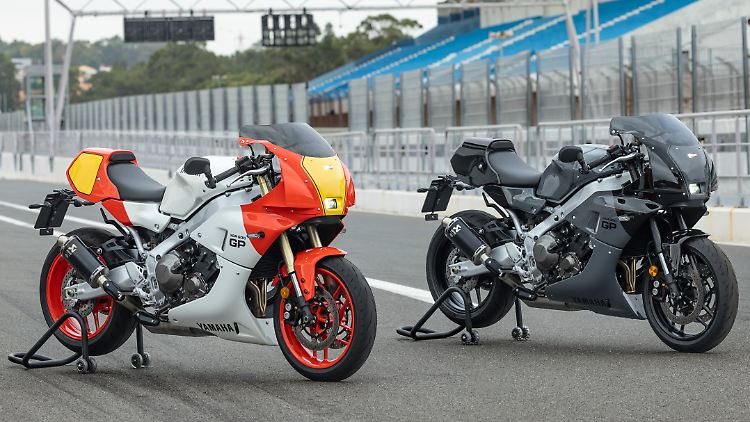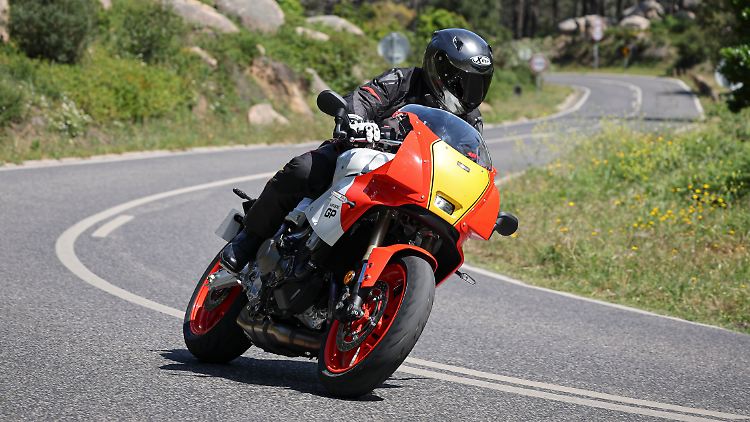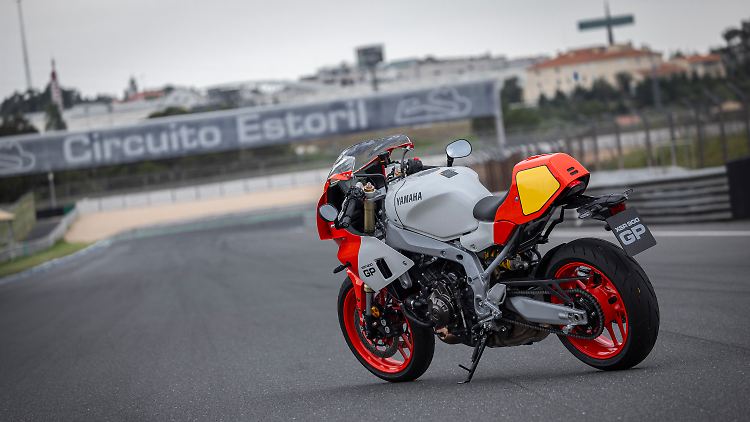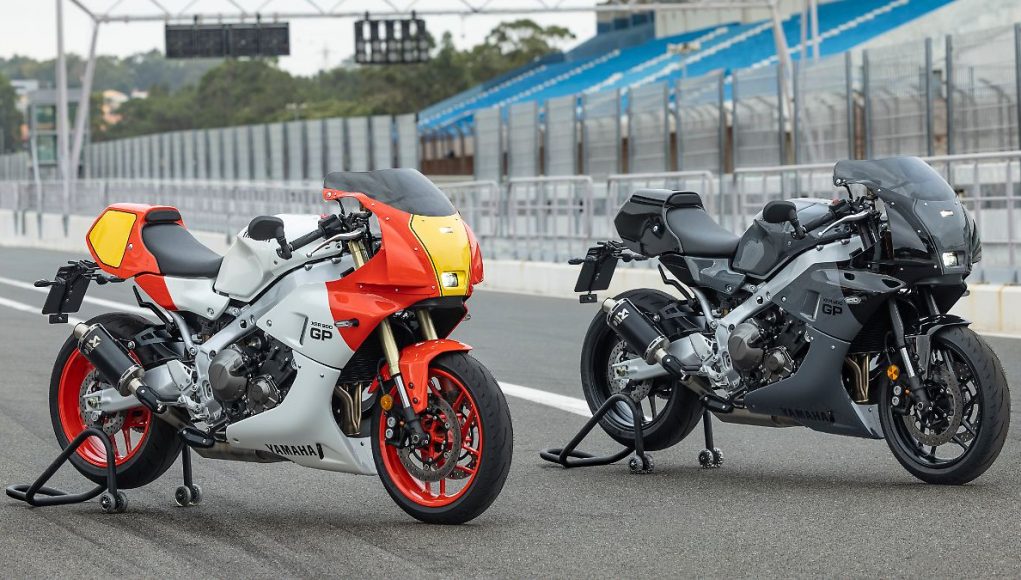Country road bike in the driving report
Yamaha XSR 900 GP – retro meets niche
This audio version was artificially generated. More info | Send feedback
Based on the 2022 XSR 900, Yamaha has combined the excellent from the past with the very good of today and thus put the XSR 900 GP on its two wheels. It's everything but a gray mouse – despite the paint job.
The paint is gone from the legendary Estoril racetrack not far from Lisbon: the paint on the grandstands is peeling, nature is rampant and is fighting to regain some square meters that were once concrete. The legendary racing successes of Eddie Lawson and Wayne Rainey are also history; Between 1985 and 1993 the two became motorcycle world champions in the over 500cc class five times on Yamaha. Yamaha wants to commemorate these golden times with the XSR 900 GP; the new retro sports bike represents the entire era.


The Yamaha XSR 900 GP is available from around 14,000 euros.
(Photo: Yamaha)
The nine hundred with the well-known Yamaha three-cylinder (87.5 kW/119 hp) is not a vehicle for the racetrack. It is designed as a sporty country road motorcycle that also creates a wonderful vintage racing feeling on a circuit and is said to be worth 14,000 euros to fans.
Engine powerful and quite economical
The latest In addition, the triple runs well, has steam in every situation and is sufficiently economical. There is no doubt that this engine, which is used in both the MT-09 and the various Tracer9 versions, is one of the best that the market has offered in years. It is combined with the chassis of the XSR 900, which was released in 2022 and was also launched as “Sport Heritage”.


The latest XSR is powered by the renowned CP3 engine.
(Photo: Yamaha)
The cast aluminum bridge frame is a work of art; Lightweight and perfectly designed and processed down to the last detail. In the new GP it is complemented by Kayaba suspension elements, which leave nothing to be desired in road traffic: They can be customized in all parameters and are of high quality. This also applies to the Nissin three-disc brake system, which is controlled by a Brembo radial brake cylinder and, of course, controlled by a cornering-capable ABS. The tires with well-chosen dimensions also carry a seal of quality. The tire valves, on the other hand, are not convincing; they are not angled, which makes it difficult to check the air pressure.
Long tours only if you do yoga


Looking into the cockpit is a joy.
(Photo: Yamaha)
So let's swing our right leg over the angular seat hump, which covers the pillion seat in normal operation and is characteristic of the racing cars of the 1980s and 1990s. The moderate clip-on handlebars contribute to a sporty sitting posture. The seat is comfortably shaped, the footrests are mounted higher and further back, the handlebar grips are placed further forward and lower than on the well-known MT-09, the original Yamaha. Compared to this, the swing arm was extended by 5.5 centimeters.
Extensive tours are easily digested by those who regularly do their yoga exercises. After the age of 50, the neck, wrists, hips and knees no longer like to take everything. But the seating position is perfect for atmospheric excursions and brisk weaving on winding roads with good asphalt; The wind protection is ok, the knee fit on the tank is good.


The TFT display is easy to read.
(Photo: Yamaha)
Looking into the cockpit is a real pleasure: the fairing is secured with split pins to a delicate tubular steel construction, and the fork caps are twisted. Switches and levers, on the other hand, correspond to the latest Yamaha standard.
This also applies to the IMU-based driving assistance electronics including wheelie control and multi-adjustable traction control as well as the easy-to-read TFT display. It masters all the connectivity gimmicks and, in conjunction with a paired smartphone based on Garmin Street Cross, even displays the previously selected route as a map. If you don't use this technology, the display shows a large, semicircular tachometer; This is also a stylistic treat. Just installing the smartphone cable on the standard USB-C port is complicated; It lies under a cockpit cover, the three clips of which have to be loosened with tools.
Courage for a niche bike


The Yamaha XSR 900 GP on the Estoril racetrack: The partly gray paintwork – not so appealing.
Driving itself is a joy: the engine handles all types of driving perfectly, the chassis reacts sensitively, the braking effect is just as impressive as the stability in curves and on the motorway. Because none of this is surprising for a Yamaha, the manufacturer's courage to put such a niche motorcycle on the wheels is even more impressive. Because in all likelihood the XSR 900 GP will not have thousands of sales per year.
Not because its price of 13,900 euros is too high; it seems absolutely appropriate. Even if, from a technical point of view, it is suitable for everyday use, it still seems like a typical third-party motorcycle. And how many Yamaha fans will want to expose themselves so badly with a GP?
The latter can be done even more consistently if you buy the very harmonious race kit (just under 3000 euros): Then the inconspicuous underfloor exhaust system becomes a real Akrapovič titanium exhaust in race design, plus an engine spoiler and various other accessories that make the XSR 900 even more impressive raise to a higher level. It's nice to see that even among mass-produced manufacturers there are convinced “weirdos” who dare to leave the beaten track. But they could have saved themselves the gray paint job.
Technical data Yamaha XSR 900 GP
- engine: Liquid-cooled three-cylinder in-line engine, 890 cc displacement, four valves per cylinder, DOHC, 87.5 kW/119 hp at 10,000 rpm, 93 Nm at 7000 rpm; Injection, 6 gears, chain
- landing gear: Cast aluminum bridge frame, motor supporting, 4.1 cm diameter USD front fork, fully adjustable with high/low speed compression damping, 13 cm travel; Cast aluminum rear swingarm, fully adjustable with high/low speed compression damping, 5.25″ travel; cast aluminum wheels; Tires Bridgestone S23 front 120/70 ZR 17, rear 180/55 ZR 17; 29.8 cm diameter double disc brake at the front, 24.5 cm diameter single disc brake at the rear
- Assistance systems: Three riding modes preconfigured (Rain, Street, Sport) plus 2x Custom, adjustable traction control, wheelie control, adjustable ABS including Supermoto ABS (all suitable for lean angles), two-way quickshifter, automatic turn signal reset,
- Dimensions, weights and consumption: Wheelbase 1.50 m, seat height 83.5 cm, weight ready to drive 200 kg. Tank capacity 14 l, standard consumption 5.0 l/100 km
- Driving performance: Maximum speed over 200 km/h
- Colors: Legend Red, Power Gray; Delivery from May
- Price: from 13,900 euros including additional costs































